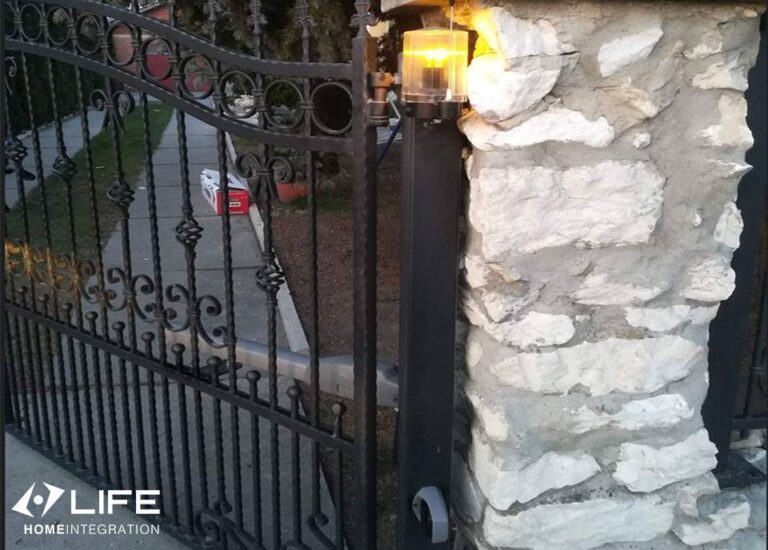Defective gate photocell: what to do?
Photocells for gates: the guide for detecting any faults and knowing how to intervene correctly:
We have already discussed photocells in a previous article and how important they are in completing the security of an automation system.
Unfortunately, we still hear stories in the news about incidents related to wear, lack of maintenance or incorrect installation of gates and automation units. LIFE Home Integration is committed to promoting correct information in order to combat news we don’t want to hear and shouldn’t have to hear.
It is perhaps because of these unfortunate true stories that we came to understand the basic importance of photocells for automatic gates (whether sliding or swinging), when we realised how they directly impact on the issue of safety.
What photocells are and how they work
A photocell is an electronic device with various fields of application: it can be used for completing the installation of motors for automatic gates and doors, as well as for alarms and anti-theft devices.
In our case, they are used because they can detect obstacles between the doors or in front of a moving door (depending on whether it is a sliding or swinging gate) and then send the signal to the control unit and thus secure the system.
Photocell faults: a guide to correct troubleshooting
Now we come to the main subject of this article:
- how do you recognise a fault in the photocell of your electric gate?
- How do you intervene properly and what should you do if the photocell of your automatic gate has stopped working?
These devices are often installed outdoors, where they are directly exposed to the elements. This is one reason why they sometimes may stop working.
In order to find out whether or not the fault lies with the pair of photocells, the first check is to simply wave your hand in front of the photocell and listen; if you hear a click, the photocell is working; otherwise it is faulty.
Often, however, the fault can be remedied by making minor adjustments without having to actually replace the equipment.
Below is a brief list of the main things to do if the photocell of your automatic gate is not working:
- Remove the plastic covers of the photocells to check that the circuit boards
inside are clean and there are no cobwebs, insects or anything else that may prevent proper operation.
- Make sure there are no foreign bodies obstructing the photocells’ range of action: any shrubs
climbing plants, weeds or flowers growing in front of the photocells can hinder the gate’s efficient operation.
- If the photocells are wireless or with at least one wireless element (generally the
transmitter), you might need to replace the batteries.
- Check that the transmitter and receiver (the 2 elements making up the photocell) are
properly aligned with one another and have not been moved.
Having performed these checks, you can verify directly from the control unit whether or not the problem has been solved.
Now observe the terminal block, where the photocell connection inputs are located (check the correct number on the motor instruction manual, as they vary depending on the model): during correct operation you will see the corresponding LED light up. If it is not lit, then the photocell is not connected correctly or is faulty.
The Digital LIFE control unit by LIFE Home Integration was created to make programming as simple as possible by means of a carefully designed system of LED lights that communicate the correct connection of the various outputs. This is why it is important that the installer does nothing more than make the connections in accordance with the information in the manual, without intervening in any other way on the board.
In some cases, however, it may occur that even when the “click” signalling the correct operation of the photocells is heard, the cells fail to work correctly and the LED on the control unit is therefore not lit. In this case it is always better to request the help of a technician.
Features and advantages of LIFE Home Integration photocells
Let’s now take a closer look at the LIFE range.
The photocells for automatic gates offered by LIFE Home Integration differ from other solutions on the market particularly in terms of their resistance over time and their robustness, guaranteed above all by the fact that they are built with plastics designed and manufactured directly at the company’s headquarters in the province of Treviso.
The 100% Made in Italy quality of LIFE Home Integration applies not only to motors, but to the entire product range, including photocells.
Inconveniences such as moisture penetrating into the photocells, breakdowns caused by poor-quality plastics or malfunctions stemming from cheap electronics simply do not arise with products manufactured by LIFE Home Integration.
Another overarching aspect of the entire LIFE range is its absolute ease of installation – an essential factor prioritised as early as the design stage of all our products, because it embodies one of the company’s core values: the desire to simplify your life when you choose to rely on LIFE Home Integration.
